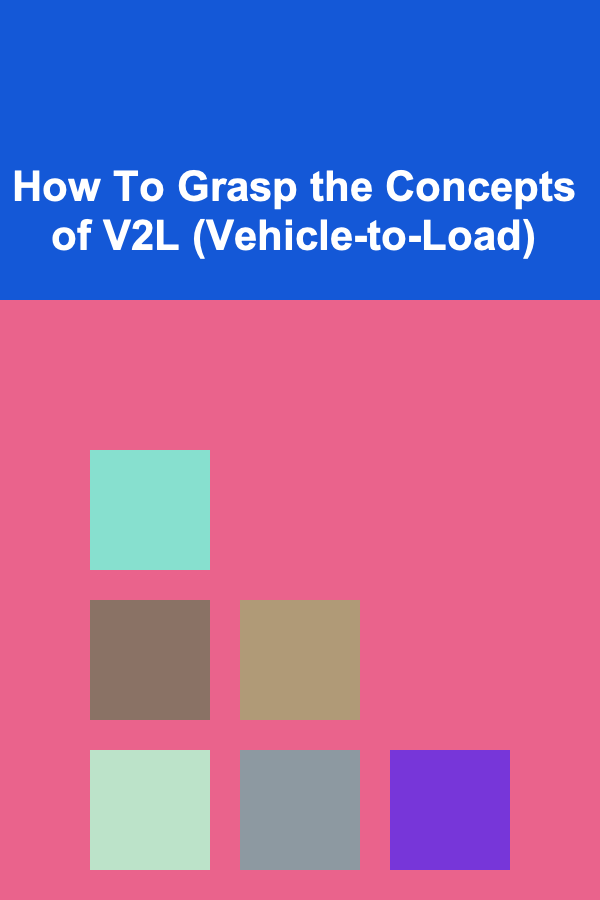
How To Grasp the Concepts of V2L (Vehicle-to-Load)
ebook include PDF & Audio bundle (Micro Guide)
$12.99$8.99
Limited Time Offer! Order within the next:

The automotive industry has witnessed an explosion of technological advancements over the past few decades, with electric vehicles (EVs) at the forefront of this transformation. Among the most promising features gaining traction is the concept of Vehicle-to-Load (V2L). This innovative system allows electric vehicles to serve as mobile power sources, transferring energy from the vehicle's battery to other devices or appliances. This article will explore V2L technology, its potential applications, technical workings, and the significance of this technology in the future of energy use.
Introduction to V2L
Vehicle-to-Load (V2L) refers to the capability of electric vehicles (EVs) to deliver power to external loads, such as household appliances, electronics, or even other vehicles. Essentially, V2L turns an EV into a mobile generator, enabling it to provide energy to power devices while not being directly connected to a power grid.
While the focus of the electric vehicle market has traditionally been on the vehicle's ability to draw energy from the grid (vehicle-to-grid or V2G), V2L introduces a new and equally intriguing angle: the ability to push energy back out from the vehicle's battery. This feature not only expands the range of applications for EVs but also provides a valuable resource in emergency situations or off-the-grid locations.
The Concept of V2L in Simple Terms
At its core, V2L enables an EV to act as an intermediary between its energy storage (the battery) and external electrical devices. The vehicle's onboard power inverter facilitates the conversion of the stored DC (direct current) power into AC (alternating current) electricity, which is the standard for most home appliances. By connecting devices to the vehicle's power outlets, users can access energy without relying on the power grid.
Key Advantages of V2L Technology
- Emergency Power Supply: In areas affected by natural disasters or power outages, V2L-equipped vehicles can provide a temporary power source, ensuring basic needs are met until the grid is restored.
- Off-Grid Capability: For those living in remote areas or engaging in outdoor activities such as camping, V2L can offer an independent, sustainable energy solution.
- Reduced Reliance on Traditional Power Sources: By allowing EVs to provide power to homes or other vehicles, V2L reduces the dependency on fossil fuels, contributing to a more sustainable future.
The Technical Framework Behind V2L
Understanding the technical aspects of V2L is crucial to grasping how this technology functions and how it integrates into the broader ecosystem of energy usage. Below, we explore the critical components of a V2L system.
Battery and Inverter System
Electric vehicles rely on high-capacity lithium-ion batteries to store energy. These batteries are designed to provide power to the vehicle's motor, enabling it to drive efficiently. In a V2L system, the same battery can be used to power external devices. However, since the devices that need to be powered typically require AC electricity, the vehicle must have an onboard inverter to convert the DC power stored in the battery into AC power.
The inverter acts as a bridge, ensuring that the energy output is compatible with the external devices being powered. Depending on the specifications, V2L inverters can typically provide between 110V to 220V AC, which is standard for most appliances.
Energy Transfer Mechanism
The energy transfer mechanism in a V2L system operates through a connection between the vehicle and the load. Typically, this is achieved using an external cable that connects from the EV to a power outlet or device. This setup allows for continuous and controlled energy flow from the vehicle to the connected load.
Advanced systems may incorporate smart meters or software that allows the user to monitor energy usage, adjust power output, and even prioritize certain devices over others based on needs.
Charging and Discharging Efficiency
One of the important considerations in V2L systems is the efficiency of both the charging and discharging processes. The amount of power the vehicle can provide to external devices depends on the remaining charge in its battery and the load it is powering. Efficient systems minimize losses in energy conversion, ensuring that as much power as possible is made available for external use.
Applications of V2L Technology
V2L technology opens up a wide range of applications, both in everyday life and in emergency situations. Below, we delve into some of the most impactful use cases for V2L.
3.1 Powering Household Appliances
One of the most direct uses of V2L is for powering household appliances during a power outage. With the capability to provide up to several kilowatts of power, a fully charged electric vehicle can supply power to lights, refrigerators, televisions, and even air conditioning units for a limited period.
This makes EVs equipped with V2L technology incredibly valuable in regions that experience frequent power outages or areas that rely on renewable energy sources, which might not always be stable or consistent.
3.2 Remote Locations and Camping
Outdoor enthusiasts and remote workers can also benefit from V2L. With the ability to power lights, cooking equipment, heating devices, and even small electrical appliances, an EV with V2L functionality makes it easier to live off the grid or have power in a camping setting without relying on gasoline generators.
Electric vehicle manufacturers are already exploring portable power stations and camping-specific accessories designed to enhance the V2L system, making it a perfect solution for adventures in nature.
3.3 Emergency Situations
Natural disasters like hurricanes, earthquakes, and floods can disrupt power grids for extended periods. In such cases, having an EV that can serve as a power source can be invaluable. In emergencies, a V2L-equipped vehicle can provide vital energy for medical devices, food preservation, and basic communication equipment.
The importance of V2L in such situations cannot be overstated, as it offers both a backup power solution and peace of mind for those in affected areas.
3.4 Mobile Offices and Events
For businesses, particularly those in event management or fieldwork, V2L can provide the necessary power for running equipment in environments where power outlets are scarce. From powering portable offices and pop-up shops to supporting equipment at outdoor events, V2L enables seamless operation without the need for cumbersome generators or external power sources.
3.5 Vehicle-to-Vehicle Charging
In some situations, an electric vehicle may also be used to charge another electric vehicle. Through V2L technology, a vehicle can share its battery's charge with another, ensuring that both vehicles can reach their destination or continue operating until they are able to access a charging station.
This capability is particularly useful in long-distance travel, especially in regions where charging stations are sparse or when traveling through isolated areas.
The Future of V2L: A Sustainable Energy Ecosystem
The future of V2L technology is inherently tied to the growth of electric vehicles and the transition toward renewable energy systems. As more vehicles are equipped with V2L functionality, we could see a shift in how energy is distributed and consumed.
4.1 Energy Storage and Grid Support
In the long term, V2L systems could play a pivotal role in the development of decentralized energy grids. As electric vehicles become more common, their batteries could be used to store energy during off-peak hours when demand is low, then discharge that energy back to the grid or individual homes during peak periods.
This type of system, known as Vehicle-to-Grid (V2G), complements V2L and could significantly reduce reliance on centralized power plants. Moreover, the integration of V2L with smart home technologies could create highly flexible, energy-efficient ecosystems that adapt to real-time energy needs.
4.2 Integration with Renewable Energy Sources
As the world shifts towards renewable energy sources, V2L can play a crucial role in balancing energy production and consumption. Solar panels, for instance, often produce more energy than is needed during the day. V2L can enable homes with solar power systems to store excess energy in EV batteries, which can later be used to power appliances or even be fed back into the grid.
This symbiotic relationship between EVs and renewable energy could be central to achieving more sustainable energy practices.
4.3 Advancements in Battery Technology
Battery technology continues to evolve rapidly, with improvements in energy density, charging speed, and overall efficiency. As battery systems become more advanced, V2L technology will likely become more efficient and capable of delivering more power over longer durations. This, in turn, will increase the practical applications of V2L and further integrate EVs into everyday life.
Conclusion
V2L (Vehicle-to-Load) represents a transformative step forward in the way electric vehicles interact with the world around them. By enabling EVs to supply power to external loads, this technology broadens the scope of EV usage beyond transportation, making them valuable tools for home power backup, outdoor activities, emergency situations, and even supporting other electric vehicles.
As electric vehicles continue to proliferate and battery technologies improve, V2L systems will become a more integral part of our daily lives. With the potential to reduce reliance on the grid and facilitate a more sustainable energy ecosystem, V2L stands as one of the most exciting innovations in the green energy movement. Grasping the full potential of this technology means understanding its technical underpinnings, practical applications, and the future role it will play in the evolution of energy usage.

How to Become a Freelance Writer and Work from Home: An Actionable Guide
Read More
How To Build a Simple E-commerce Site
Read More
How To Understand Human Resources for Small Businesses
Read More
How to Manage Caregiver Burnout
Read More
How to Master the Art of Simplification
Read More
10 Tips for Senior Travel To-Do List Planning
Read MoreOther Products

How to Become a Freelance Writer and Work from Home: An Actionable Guide
Read More
How To Build a Simple E-commerce Site
Read More
How To Understand Human Resources for Small Businesses
Read More
How to Manage Caregiver Burnout
Read More
How to Master the Art of Simplification
Read More